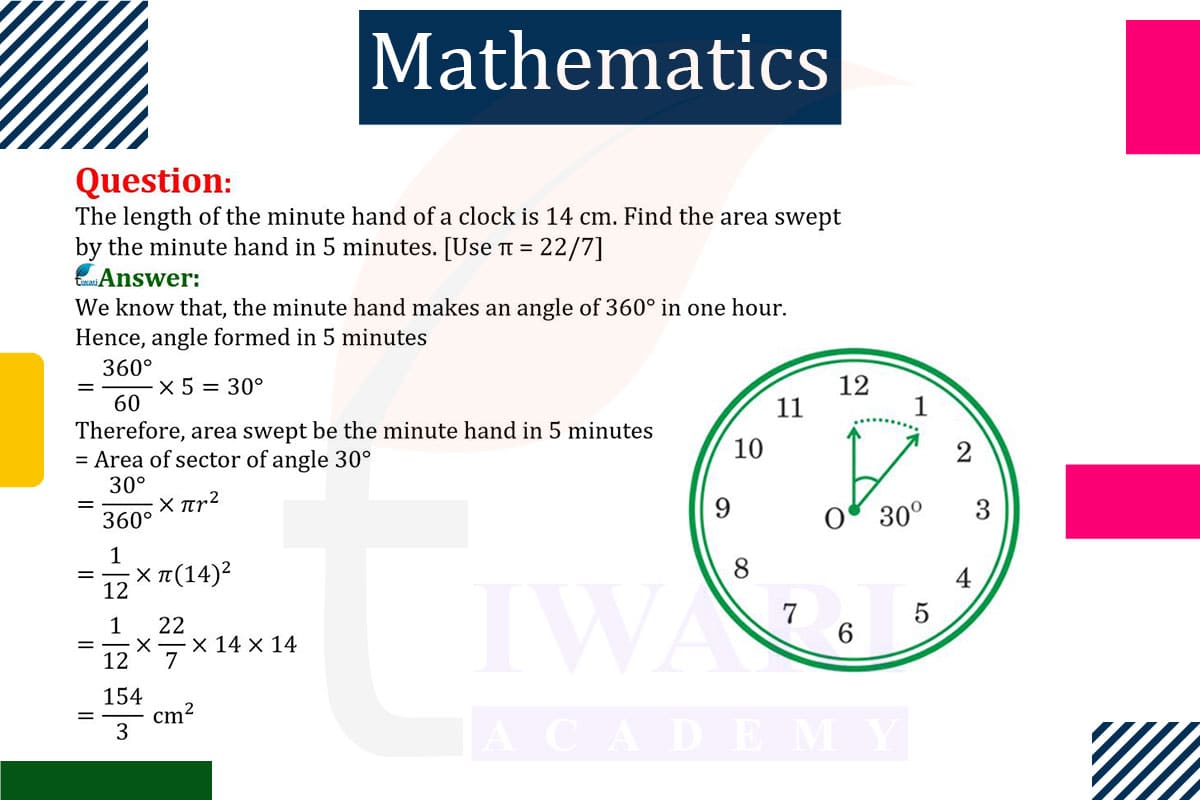To find the area swept by the minute hand of a clock in 5 minutes, consider the minute hand as the radius of a circle forming a sector. The length of the minute hand is 14 cm, which is the radius. In 5 minutes, the minute hand covers 5/60 of an hour, or
1/12 of a full circle (360°). Therefore, the angle of the sector is 360°/12 = 30°. The area of a sector is given by Area = (θ/360) × πr². Substituting θ = 30° and r = 14 cm, the area swept is (30/360)×π×14² cm², which equals approximately 54.98 cm². This calculation shows the area covered by the minute hand in 5 minutes.

Let’s discuss in detail
Calculating the Area Swept by a Clock’s Minute Hand
The concept of calculating the area swept by the minute hand of a clock over a given time interval is a fascinating application of geometry in everyday life. This calculation involves understanding how the movement of the minute hand over time corresponds to the formation of a sector in a circle. The minute hand’s path over a specific duration, such as 5 minutes, creates a sector whose area can be calculated using the principles of circle geometry. This task not only demonstrates the practical application of geometric concepts but also provides insight into how time and geometry can intersect in our daily experiences.
Understanding the Movement of the Minute Hand
The minute hand of a clock moves in a circular path, completing a full rotation (360 degrees) every hour. To determine the area swept by the minute hand in a specific time frame, it’s essential to understand the proportion of the circle that the hand covers during that period. In 5 minutes, the minute hand covers a fraction of its total circular path. This fraction is key to calculating the sector’s angle, which is crucial for determining the area swept by the minute hand.
Calculating the Sector’s Angle
In 5 minutes, the minute hand of a clock moves through a certain angle. Since the hand completes a full rotation (360 degrees) in 60 minutes, in 5 minutes, it covers 5/60 th of 360 degrees. This calculation gives us the angle of the sector formed by the minute hand’s movement. The angle is essential for calculating the area of the sector, as it determines the portion of the circle that the sector represents. Understanding this relationship between time and angle is fundamental in solving the problem.
Determining the Radius and Applying the Formula
The length of the minute hand is given as 14 cm, which serves as the radius of the circle formed by its movement. The area of a sector is calculated using the formula Area = (θ/360)×πr², where θ is the angle in degrees and r is the radius. By substituting the calculated angle and the given radius into this formula, we can find the area swept by the minute hand in 5 minutes. This step is crucial as it combines the geometric formula with the specific measurements of the clock’s minute hand.
Practical Implications of the Calculation
Calculating the area swept by a clock’s minute hand is not just a theoretical exercise; it has practical implications in fields like engineering and design. For instance, in designing clock faces or in artworks involving circular motion, understanding this concept can be crucial. It also enhances our appreciation of the geometry in everyday objects and phenomena. This calculation is a perfect example of how mathematical concepts are deeply embedded in our daily lives, often in ways we might not immediately recognize.
Geometry in Everyday Life
In conclusion, calculating the area swept by the minute hand of a clock in 5 minutes is a practical application of geometry that combines concepts of angles, sectors, and circle properties. This exercise not only reinforces the understanding of geometric principles but also illustrates the fascinating ways in which mathematics is intertwined with everyday objects and experiences. It serves as a reminder of the beauty and utility of mathematics in interpreting and understanding the world around us.
Discuss this question in detail or visit to Class 10 Maths Chapter 11 for all questions.
Questions of 10th Maths Exercise 11.1 in Detail

